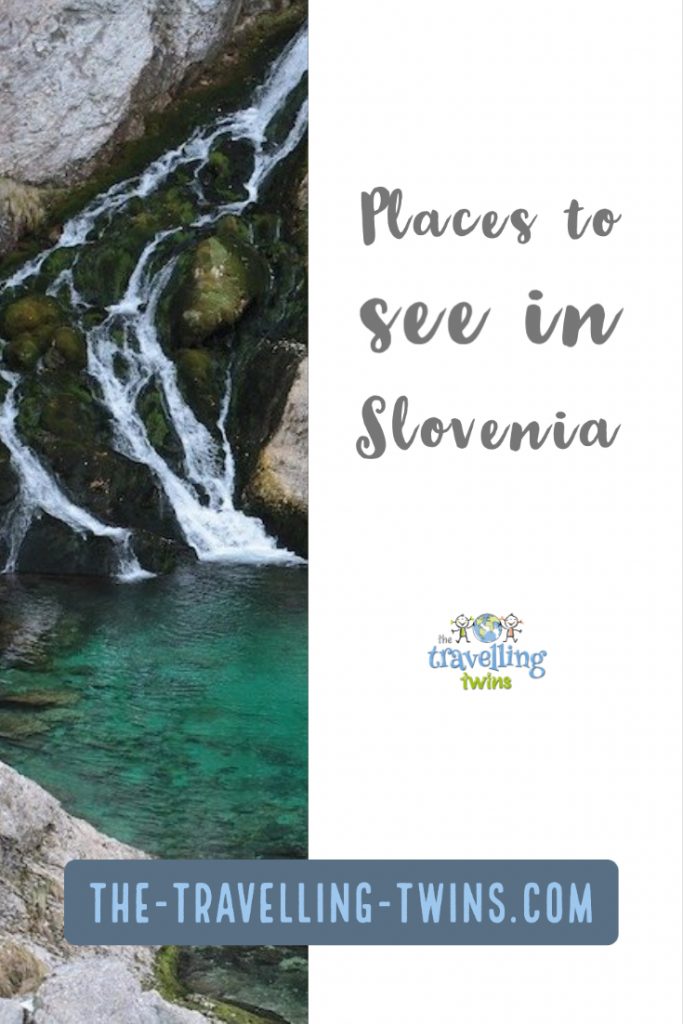
On our campervanning trip through Europe, we spent some time camping in Slovenia. Unfortunately, we spent too little time in this gorgeous country to see all it had to offer. So I have asked other bloggers to join me here in recommending our favourite places to visit in Slovenia.
But first, let me give you some general Knowledge about Slovenia
Slovenia General Knowledge
Where is Slovenia?
Slovenia is a small country in South-East Europe to the South of Austria. For most of the twentieth century, it was part of Yugoslavia. As well as Austria, Slovenia shares borders with Italy, Hungary and Croatia, it also has a small coastline onto the Adriatic Sea.
Is Slovenia safe?
Yes, it is. We always felt very safe and comfortable when we were wild camping in Slovenia. People were universally friendly. We never felt threatened and nothing was stolen – (though we are always pretty careful – the only thing we lost on our whole six month trip was to muggers in a Greek coast town).
Is Slovenia worth visiting?
Yes, absolutely., Slovenia is one of the most beautiful countries we have visited. To tell the truth, Slovenia’s beauty took us by surprise. Beautiful rural landscapes, unspoilt by litter or advertising hoardings, tasty wine and the amazing Slovenian caves.
We were just planning to cross through Slovenia on the way to Venice. But we loved it so much that we stuck there for a bit longer. But even so we didn’t find everything there is to see, so read on here to find not only our favourites, but also the best Places to See in Slovenia from other travel bloggers too.
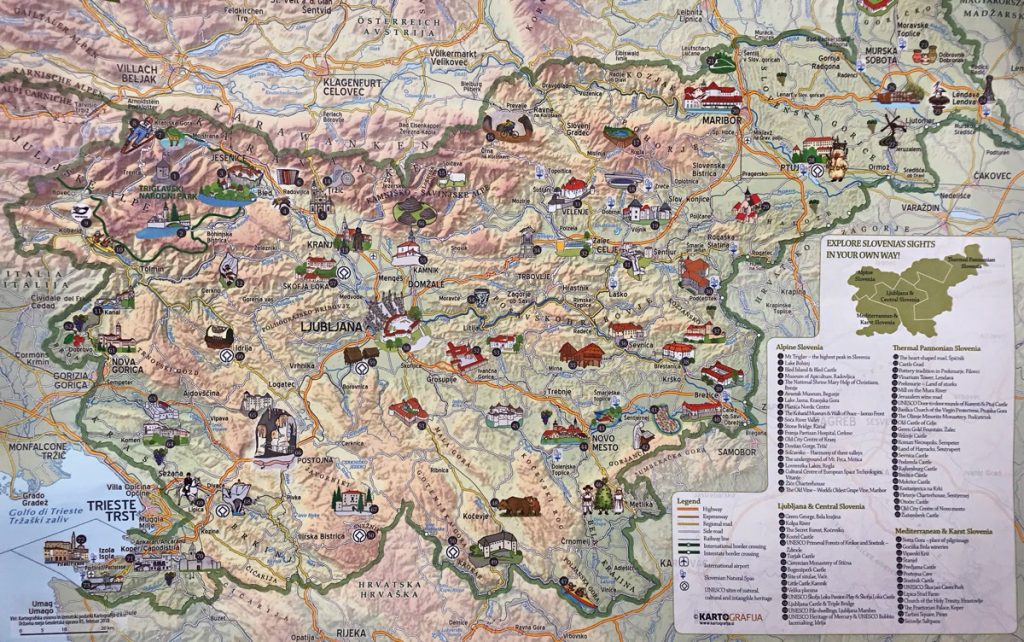
Regions in Slovenia
Slovenia is divided into four regions
- Thermal Pannonian Slovenia
- Ljubljana & Central Slovenia
- Alpine Slovenia
- The Mediterranean & the Karst in Slovenia
Places to see in Slovenia by regions
Thermal Pannonian Slovenia
Thermal Pannonian Slovenia is famous for hot springs and healing waters. This was where we entered Slovenia from Hungary. We were welcomed by a friendly guy at the official information point who advised us to stick to secondary roads to avoid the need for buying a vignette (visitors road tax) It was great advice, the roads were good and they led us to beautiful rural areas; towns build around health spas and wineries.
Celje
Looming large over the Celje city, Celje Castle was originally a walled Romanesque fortress in the 12th Century. New defensive structures were added in the 14th Century by the Counts of Celje, the most influential nobles in Slovenian history. After their decline, the castle fell into ruins. It was only at the end of the 19th Century that it was handed over to the Celje Museum Society. The castle became a popular tourist attraction and the castle of famed stories was saved from fading away into the forgotten history.
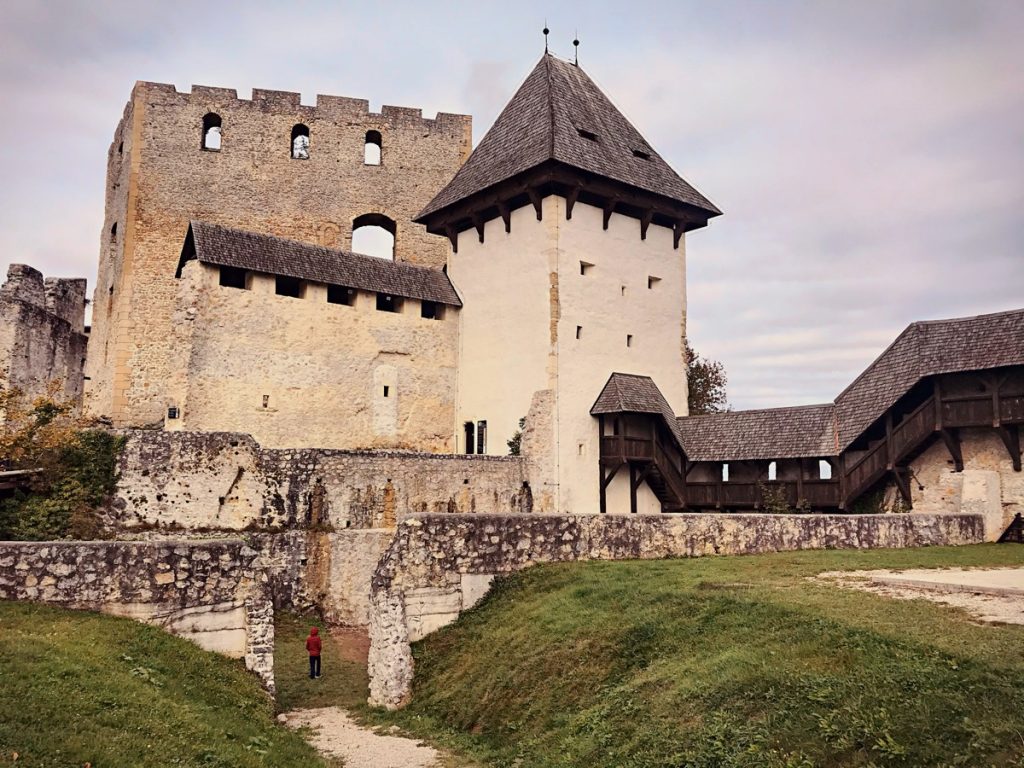
The castle is now a picturesque scene of beautiful ruins. Its old-world feel and romantic history attracts many couples across the globe as their wedding destination. The square towers and the Zice Monastery was unmissable. We heard that medieval-themed parties and concerts are regularly held in the warmer months of the year making it a hot spot for tourists. The climb up to the top of the castle tower was well worth the effort, offering a spectacular birds-eye view of Celje town and the surrounding countryside.
Jeruzalem
The main reason why we visited Jeruzalem was the name. I was intrigued, and I thought it would be fun to say we had visited Jeruzalem on our European trip.
Legend says that the name Jeruzalem was given by Crusaders who stopped here on the way to the holy land. They liked the place and its wine so much that they decided to stay here permanently; keeping the original destination of their mission by the change of name – seems a little naughty to me but I could sympathise with their decision. We felt for this place and its wine too.
Jeruzalem is a small village located on a hill at an elevation of 340m above sea level, It is surrounded by vineyards and apple orchards. The surrounding lanes were perfect for our hike – or it would be great if a bit hilly for a bicycle ride. If you are a wine connoisseur you should visit the Ljutomer in Ormož region. There you can take one of two wine routes – Jeruzalem Wine Road or Ormoz wine road.
As we walked around the area we enjoyed spotting and listening to the clackety clack of wind powered wooden rattles and their ingenious archaic wooden engineering.
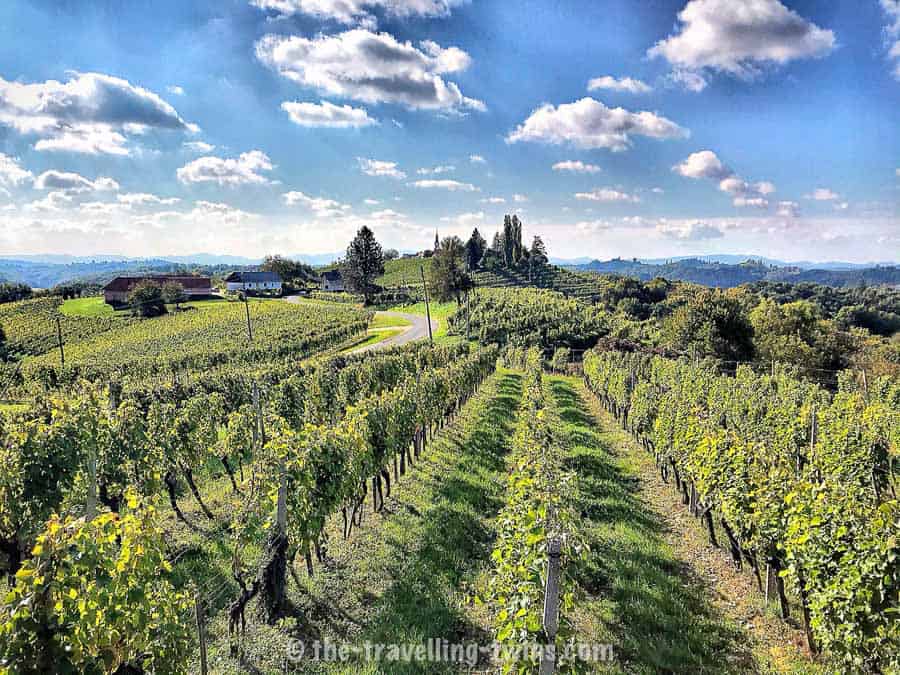
Contributed by Ania from The Travelling Twins
Ljubljana and Central Slovenia
Ljubljana is the capital of Slovenia and the heart of the country. The region around is called Central Slovenia. It is very green and loaded with interesting destinations.
Ljubljana
The Name of the capital city of Slovenia Ljubljana sound similar to the Slovenian word “beloved” (Ljubljana–ljubljena). With its old-world charm small restaurants, cafes, and bridges everywhere, it reminded us of Prague. To be sure the largest city of Slovenia is a delightful place. Every nook and corner of the city kept the old-town feel alive. And seeing all the cafes, we instantly felt hunger pangs.
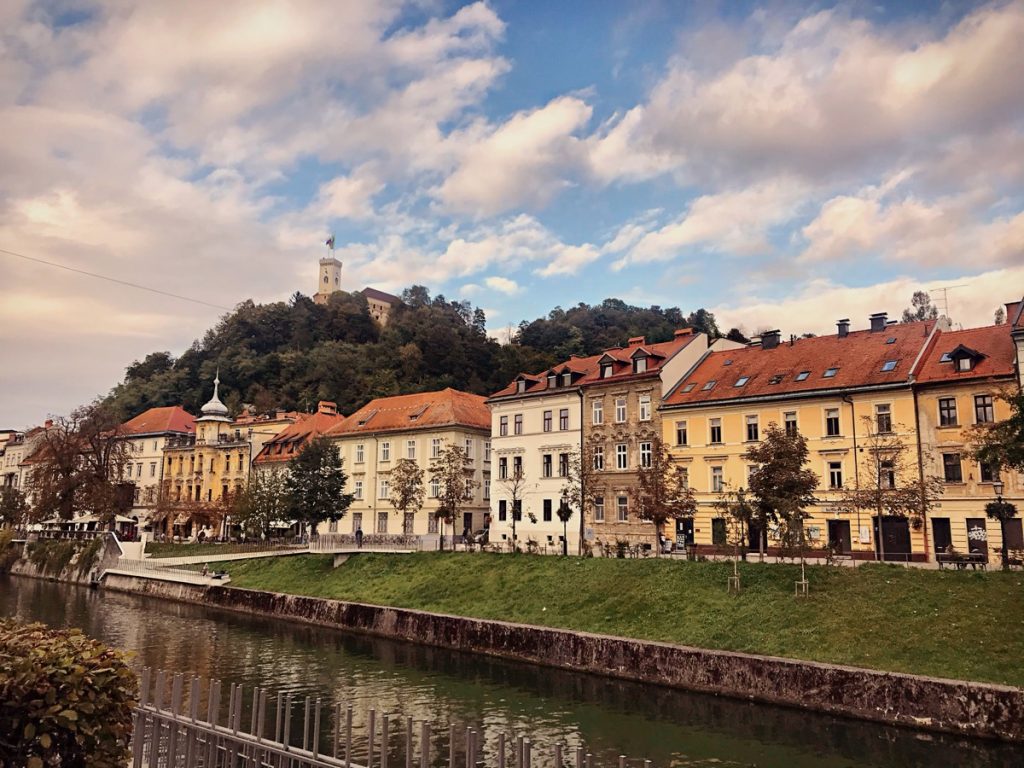
When we visit a city, it’s always a conscious effort to get a taste of authentic dishes. And the search led us to Ljubljana’s oldest pizzeria Parma. Tucked at the end of the Maxi Market, this treasure trove of authentic pizzas is hidden under the stairway. Just a step inside the place, you’ll know why it has survived competition from modern pizzerias and bars for decades.
Another thing that caught our fancy was Cooperative Commercial Bank’s building. Wondering why? The colors and decorative painting of the building are sure to catch the fancy of anyone. The bright red facade and its wall paintings are a paradigm for traditional Slovenian architecture.
The old town is very walkable. We explored it on bicycles and scooters.
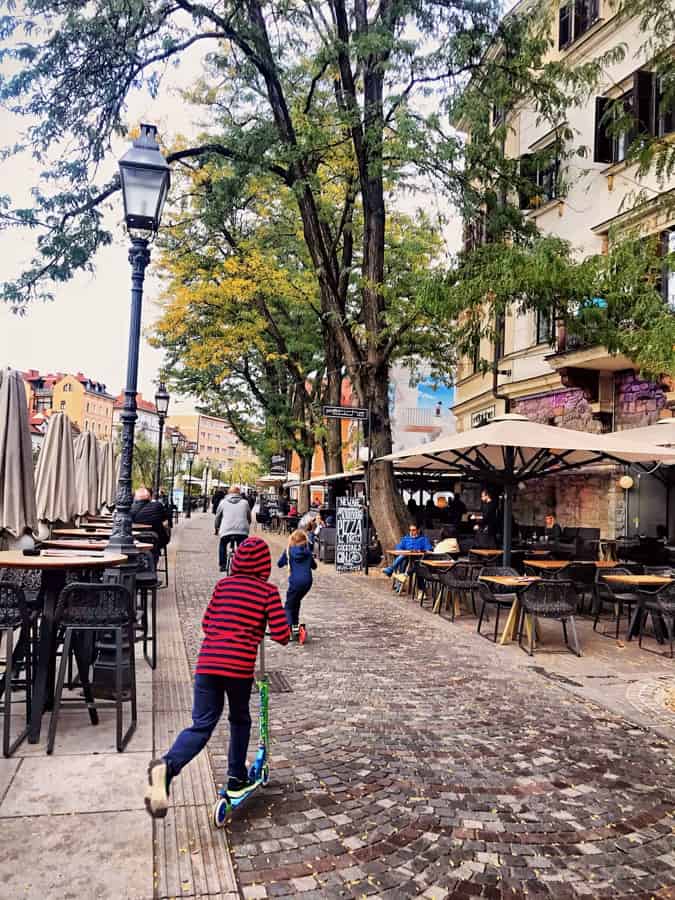
Word of advice: If you want to visit the beautifully restored castle (and you do) be ready to carry your scooter or lock your bike at the bottom of the hill, as the road involves lots of steps.
Short of time, but we made sure to visit the National Museum of Slovenia to see the famed Neanderthal flute which is 60,000 years old and was excavated from the Divje Babe site.
Our girls loved spotting statues of dragons spread all over the city.
Contributed by Ania from The Travelling Twins
Velika Planina
Velika Planina is an idyllic high mountain plateau in the northern part of Slovenia, famous for its lush green pastures and picturesque herdsmen’s village, consisting of traditional Alpine herdsmen huts.
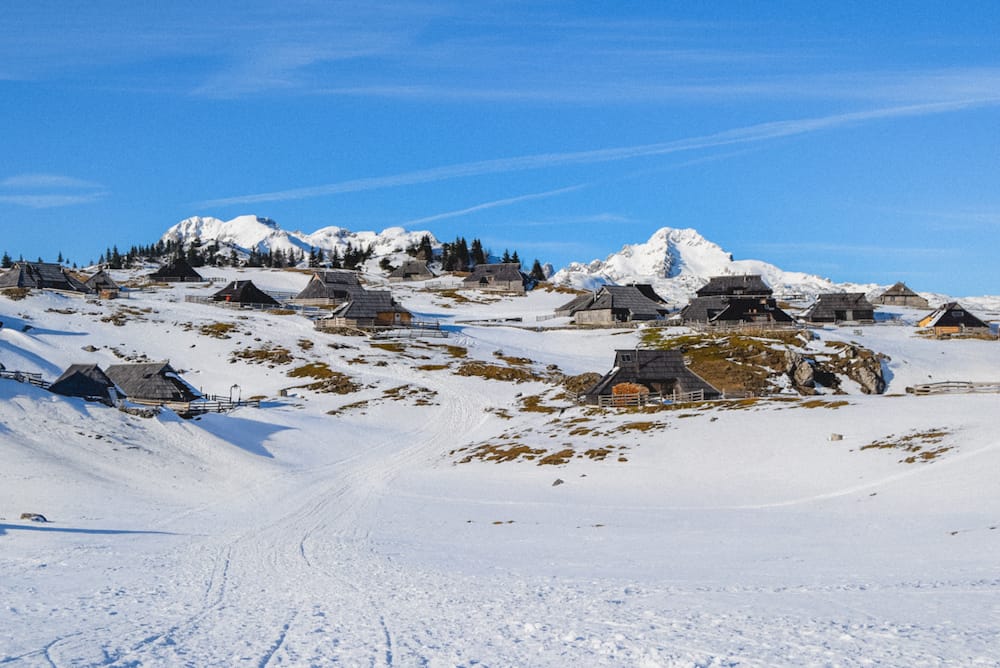
Every summer herdsmen bring their herds to the mountain and Velika Planina turns into a scenic out-of-the-Milka-Chocolate-commercial place. Fluffy cattle are grazing in the vast sunny meadows flanked by mighty mountain peaks in the distance and herdsmen are producing cheese that can sometimes be bought in the herdsmen huts. The most significant sounds are that of cowbells or jolly hikers enjoying a traditional herdsmen’s meal such as sour milk with “žganci” (a lumpy dish from boiled flour), cottage cheese rolls or a stew in one of the several alpine huts.
The main sights at Velika Planina are Preskar’s Hut (a hut turned into a museum) and the hut-like Chapel of St. Mary of the Snows. The plateau is covered with plentiful, easy hiking trails that make for an enjoyable walk around the scenic landscape.
Several mountain hikes that lead to the plateau are of different lengths and difficulty. Still, Velika Planina is also accessible by a cable car that is located in the Kamniška Bistrica valley. Velika Planina makes a delightful day trip from Ljubljana, but for a genuine experience, there are several chalets on the plateau as well.
Not only in the summer, Velika Planina is also gorgeous at the beginning of May, when for a short time, but pastures are also covered with patches of blooming vivid purple saffron. For most of the winter, a blanket of snow covers the plateau and creates an alluring winter fairytale.
Contributed by Sandra from BlueMarble Vagabonds
Idrija
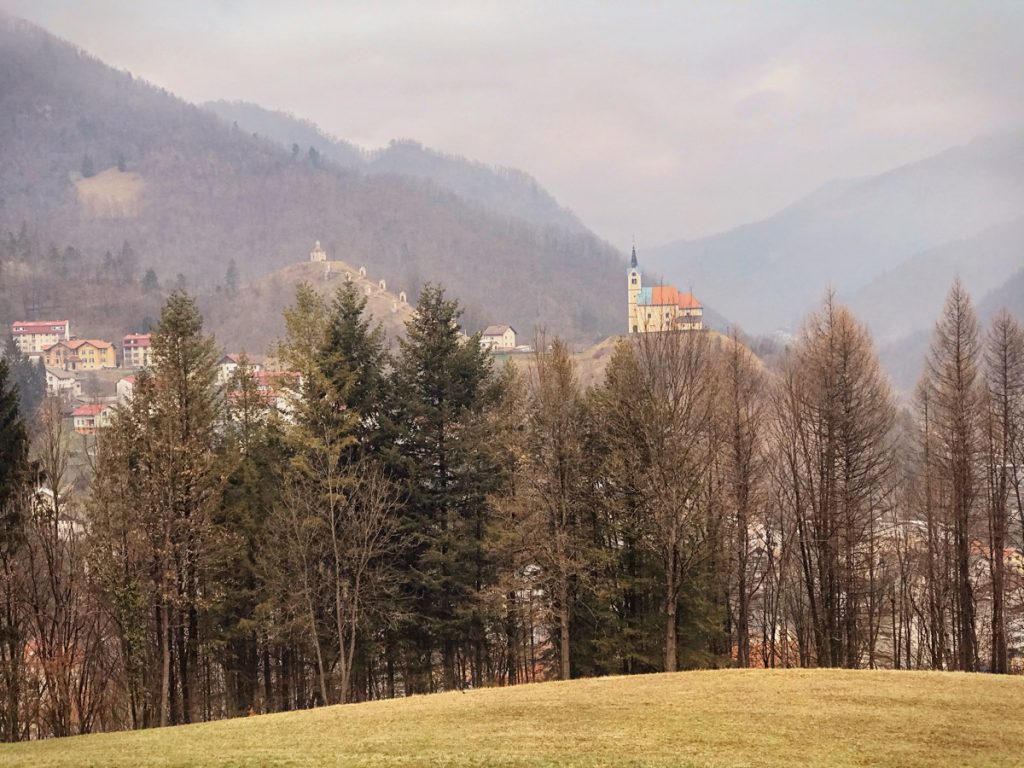
Bela Krajina
For those looking for a hidden gem in Slovenia, Bela Krajina is your best bet located in the southeastern region of the country, on the border with Croatia. Bela Krajina is characterised by vineyards, lush green countryside, and turquoise rivers making summer the best time to visit. From the capital, Ljubljana, the region can be reached within a one hour drive or two and a half hours by train to Metlika if you prefer slow (and cheap, 8 EUR one way) travel.

Bela Krajina is perfect for those wanting to experience the local and traditional Slovenian culture, and three nights is a great amount of time to experience everything on offer. Including wine tasting, vineyard visits and bread-making classes. However, the unique activity on offer has to be oil tasting at Oljarna Pečarič, where we sampled over 20 different cold pressed oils and learnt about the health benefits as well as how the oils were produced. If you love the outdoors, Bela Krajina is also perfect for watersports such as kayaking and paddleboarding as its home to the warmest river in Slovenia, the Kolpa river. If you prefer hiking, then visit one of the viewpoints, such as Mina Gora Hill or Krasnji Vrh Hill and don’t miss out on visiting the source of the Krupa river spring. A beautiful spot that would be flooded with tourists if it wasn’t in such an off the beaten track destination.
The best place to stay on a visit to Bela Krajina is BIG BERRY. Situated on the banks of the Kolpa River, the resort is made up of seven luxury mobile homes equipped with a private hot tub, WIFI, and a fully equipped kitchen. Big Berry’s philosophy is all about blending nature and local culture, so it was easy for us to book excursions in the local area through them, and explore a traditional side to Slovenia away from the crowds.
Contributed by Roshni from The Wanderlust Within
Savica Waterfall
The most famous waterfall in Slovenia is undoubtedly Savica Waterfall, located inside Triglav National Park near the triple border with Austria and Italy. Its fame is due not only to its natural beauty but also to a poem it inspired, called “Baptism on the Savica”. Written by a local poet named France Prešeren, this long lyric poem is generally thought of as the national epic of Slovenia, and every Slovenian child studies it in school.

When you first catch sight of the water tumbling out of a tunnel in the rock to the emerald pool below, it’s not hard to see how this breathtaking scenery inspired such a masterpiece. While Savica doesn’t have the power or the size of world-famous waterfalls like Iguazu, Victoria or Niagara, its grace and beauty are certainly captivating.
To reach the waterfall, take the hiking trail that begins at the Dom Savica hut. Here, you’ll need to pay a small entrance fee of three euros, which goes towards the maintenance of the trail. Savica is unfortunately not wheelchair accessible, as you’ll need to climb about 550 stairs to reach it. For most people, the climb takes about 20 minutes. At the top, you’ll find an observation platform with views of the waterfall in one direction and Lake Bohinj in the other. The lake is just a few kilometers away and can easily be visited the same day in combination with the falls. From the platform, keep walking all the way down to the gate for a closeup view of the falls.
Contributed by Wendy Wernethof The Nomadic Vegan
Kranj
Located midway between Lake Bled and Ljubljana, Kranj is a perfect destination for families who love the culture, history, and outdoor adventures.
Why would you add Kranj to your Slovenia itinerary? Well, it’s relatively unknown – meaning you’ll have the entire place to yourself. Plus, the city’s six thousand year old history makes it intriguing enough to explore. Also, nature is just around the corner so

Kranj’s proximity to Ljubljana Airport and other famous attractions in Slovenia – Lake Bled, Skofja Loka, Ljubljana, Vintgar Gorge, and Kranjska Gora makes it a perfect base to explore Slovenia.
There are tons of family-friendly things to do in and around Kranj. Stroll the cobbled streets of the historic Old Town, visit the Museum of Gronjeska to learn the history of Kranj, hike the Kokra River Canyon or Jamnik, or surprise your taste buds with Kranj’s traditional food.
And yes, how can you not drink in the views of the Slovenian Alps when in the capital of the Slovenian Alps, Kranj? Whatever you see or do, lots of learning and fun is guaranteed.
We stayed at Apartment Na Skali, a family-friendly and cozy apartment conveniently located right in the heart of the Old Town and loved every bit of our stay here. Highly Recommend.
Contributed by Anjali from the Travel Melodies
Skofja Loka
Skofja Loka has all the hallmarks of a typical Slovenian town: A half-moon stone bridge, historic houses, and a grand castle standing watch. Located just 45 minutes north-east of Ljubljana by bus, it’s well-positioned for a day trip or as a stopover on the way to Lake Bled. If you enjoy getting off the beaten path and want to spend longer in this sweet little town, there are a couple of accommodation options to choose from. Hotel Garni Paleta is conveniently located in the centre and offers river views.

Skofja Loka is quaint and small; you don’t need much longer than a full afternoon to explore everything on foot. Start by climbing Hribec Hill for a view of the cream-and-yellow Loka Castle, a 12th-century fortification that is every bit as impressive as other castles in the region. Cross to the opposite side of town via the Devil’s Footbridge (information plaques along the way will reveal the origin of the name!) and visit the Castle Museum, which displays artefacts from around Upper Carniola.
The best thing to do in Skofja Loka is stroll around town and admire the facades. The most beautiful buildings are arranged around two squares, Mestni trg and Cankarjev trg. Don’t miss Homan House, the oldest inn in town that still operates as a pub. But save your appetite for Gostilna Kašča, an excellent Slovenian restaurant located in the bottom of the historic granary. ‘Skofja Loka Mix’ (sausage, beans, millet and smoked pork) is a yummy local dish to try.
Contributed by Emily from Wander-Lush
The Mediterranean and the Karst Slovenia
Karst is name of a type of water soluble limestone, which comprises about 70 percent of Slovenia’s territory and gives it its spectacular landscape Including the greatest caves in Slovenia and to the famous Lipizzaner white stallions. The variety of places to see and things to do here is endless – notably exploring caves, hiking and enjoying the Slovenian coastline.
Lipica
You don’t need to be a horse lover to enjoy a visit to the Lipica Equestrian Park and Stud Farm at Sežana, about an hour’s drive from Ljubljana. Its central location in Slovenia makes the Park one of the great things to do in Piran and surrounds, too.
Lipica Stud Farm is home to the most famous white Lipizzaner stallions who perform for the Spanish Riding School in Vienna. This is where the horses are bred. Those that have been selected to perform in Vienna are brought here to rest during the offseason. In fact, Lipizzaners have been bred here since 1578 making Lipica the oldest European stud farm which continuously breeding one of the oldest cultural horse breeds.

After your visit, you’ll appreciate why the Lipizzaner is a revered and much loved breed.
The Park is situated in a large, leafy estate and offers numerous activities for visitors to enjoy. You can join a guided tour of the farm, watch as the horses are put through their training program, see a performance of the ‘dancing’ Lipizzaner horses, take a carriage ride around the grounds, or have a dressage lesson on one of these graceful animals.
Entry to the Park costs 16 euros per adult with children under 18 half price (summer rates). Additional charges apply for most of the activities mentioned above.
You don’t always need to enter the Park to see the horses, though. On the day we visited (in July), a large field beside the car park was full of inquisitive horses and foals who were just as interested in us as we were in them!
There are a couple of restaurants beside the Park, including one which is part of the Hotel Maestoso. If a day visit to the Lipica Equestrian Park is not long enough, why not stay the night?
A visit to the Lipica Equestrian Park is one of the best things to do in Slovenia for young and old.
Contributed by Carolyn of Holidays to Europe
Goriska Brda
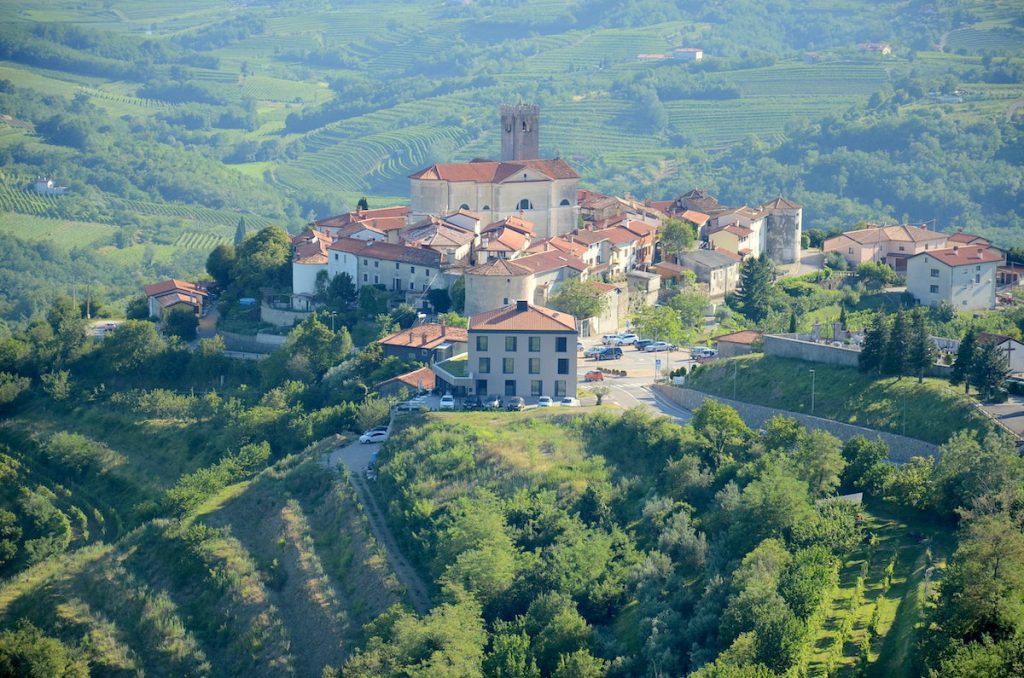
“Tucked between the Adriatic Sea and the Alps, the hilly vineyards and charming villages of Goriška Brda in western Slovenia is a great and affordable alternative to Italian Tuscany. Even though it only takes about an hour and a half driving from either Ljubljana or Venice for example, this wine region is still pretty much off the beaten track amongst international tourists and has managed to remain hidden from mass tourism. The focus here is firmly set on ecotourism and environmental conservation. So instead of big hotels, highways, supermarkets and fast-food restaurants, you will find small, family-run boutique hotels and organic farmsteads, winding narrow roads, wine cellars, galleries and local eateries where you can chat with friendly locals over a glass of wine or two. All this makes Brda a great place for everyone willing to contribute to sustainability and are in search of authentic culinary experiences in peaceful countryside. There are lots of things to do besides enjoying Mediterranean inspired food, exquisite wine tastings and sunbathing by the pool between the vineyards – you can go cycling on some 280km routes, hike a part of Alpe Adria Trail, visit Dobrovo castle, climb up the stairs of Gonjače viewing tower for the best views and walk around the villages of Medana, Šmartno, Slapnik, Vipolže and other. Besides different festivals and local celebrations going on throughout the year, it is also consistently gaining popularity as a place for hosting weddings. With so many attractive villages, you really can’t go wrong with choosing accommodation, but my favourite would definitely be Medana.”
Contributed by Katja Mikos from Place And Notes
Piran
If you’re into cute historic towns where you can walk everywhere and feel the vibe of a small community come to Piran.

Piran is a charming little coastal town 80 minutes drive west from Ljubljana. The easiest way to get there is to hire a car and drive. The road from the capital city is pretty epic, cutting through mountains and leading through suspended bridges. The town can be explored on foot. Get lost in the narrow, winding alleys all leading down to the Tartini Square named after an Italian composer and centrally located. Here you can sit down in one of the outdoor cafes which is an excellent spot for people-watching. Next, take a stroll to the marina, there are many good restaurants where you can have some fresh seafood. Visit the St. George Church on a small hill where you can get a panorama of the town’s square and the marina. It’s quite a view – historic houses with red roofs with turquoise waters of Adriatic Sea on the background. For even better vista, climb over a hundred stairs and get to the top of the church’s Bell Tower! If you’re into your history, explore the Medieval Walls of Piran dating back to 15th century. There were built to protect Piran from the Turks when the town was part of the Republic of Venice. Piran is also great for staying a little longer; there are a few beautiful beaches close by and the area is also great for cycling. If you’re looking for a place to stay – Hotel Art Tartini is located right on the main square. It’s been completely refurbished in recent years and offers a great buffet breakfast.
Contributed by Mal from Raw Mal Roams
Vipava Valley
Rolling hills, medieval hilltop villages, and lush green vineyards define Vipava Valley in Slovenia. This lesser known Slovenia destination was one of our favourite stops on our adventures in Slovenia. It is located about an hour drive from the capital city of Ljubljana and we can wholeheartedly recommend it to wine lovers or people interested in getting to know the locals and experiencing local produce.

A visit to Vipava Valley is all about wine and dining. Stay in the tiny village of Goče where you will follow the cobblestone streets and admire perfectly preserved facades of 17th-century buildings. Then, dine on the farm-to-table fare at one of the town’s locally owned restaurants.
Visit Cejkotova Domacija, which is housed in a restored 200 year old building. You can eat on the terrace under the vineyards then head down to the wine cellar for tastings afterwards. We had some excellent local Zelen, Pinela, and Klarnica wines paired with our meals.
That’s not the only wine cellar in town though. Burja Estate offers wine tastings in a first-class tasting room and tours include a visit to the cellar. It is named after the “burja” winds which consistency blow through town. Many of the wineries in town believe that the “burja” is what makes the Vipava Valley wine so special. Since it keeps grapes free of any bugs and eliminates any need for pesticides. If you visit, you will notice an emphasis on natural and organic wines!
Contributed by Sustainable Travel bloggers Oksana & Max from Drink Tea & Travel.
Alpine Slovenia
Alpine Slovenia is home to amazing hike and bike trails. It is a great place to explore rivers, lakes and the nation’s highest peaks. Alpine Slovenia is home to the most dramatic sights in Slovenia.
Maribor
Everyone has heard about Ljubljana and Lake Bled, but if you want to visit a Slovenian town with serious charm and incredible wine, then look no further than the country’s second-largest city of Maribor. Located about 130 kilometres northeast of Ljubljana in the Slovenian Styria region, there are countless interesting things to see and do in Maribor that are sure to keep travellers occupied for a day or two.

Maribor is most famous for its wine production, being situated in the heart of one of Slovenia’s most prolific areas for viticulture. Wine culture runs deep in Maribor — you can even find the world’s oldest grape-producing vine at the Old Vine House in the Old Town! At over 400 years old (not as old as Stara Maslina in Bar), the vine is still producing vintages and there is even a festival celebrating its harvest every September. You can also do a degustation of local wines at the Old Vine House café.
If you want to learn more about Maribor’s wine culture, then consider heading to the Vintage Wine Cellar. Though out of commission today, you can still tour subterranean labyrinth, either on a guided tour or on your own. There is also a café here for you to sample even more of the local vintages!
If all of that wine doesn’t interest you, there are still a number of things in Maribor to keep you occupied. If you want to learn more about Slovenia’s recent history, consider spending an hour or two in the Museum of National Liberation. If you would rather be a bit more active, take a stroll through the City Park or hike up the grapevine-lined Pyramid Hill for incredible views of Maribor and the surrounding countryside.
Of course, no trip to Maribor would be complete without letting yourself get lost wandering the cobbled lanes of the pedestrianised Old Town and taking in its charming sites while enjoying only a fraction of the visitors that cities like Ljubljana receive.
All in all, Maribor is one of the best towns to visit in Slovenia if you want an alternative to the capital while avoiding the tourist crowds.
Contributed by Maggie from The World Was Here First
Triglav National Park
Located in the north-west of Slovenia, around 40 minutes drive from the capital city Ljubljana, Triglav National Park is the only National Park in Slovenia, and trust me; it’s worth a visit.
Set in the Julian Alps, Triglav is a paradise for outdoors’ lovers. It has everything you’ll need, from alpine lakes to mountain huts, hikes and wildlife.

It’s a big area, and there are plenty of things to do in the park: Whether you’re visiting for a day, or for a full week, you’ll have no shortage of things to do in the park.
Here are a few of the best things to do in Triglav:
- walk the seven lakes hike, a 2-days hike where you’ll see seven alpine lakes in the park
- see the Kozjak waterfall, one of the most beautiful waterfalls in Slovenia
- go for a swim at Lake Bohinj, or rent a kayak and paddle on the (often cold) water
- sleep in a mountain hut at the top of the mountain and watch the stars at night
- explore the Soca river area and bathe in pure water straight from the mountains
For your visit to Triglav, you have several options for accommodation. You can either make it a day trip or you can stay longer in the park. If you stay longer, you can sleep in a mountain hut during a multi days hike, or rent a hotel nearby. Check out the House DorMica a nice apartment for rent near the park.
Contributed by Kevin from KEVMRC
Bohinj
Bohinj is a big valley in northwestern Slovenia centered around Lake Bohinj (Bohinjsko Jezero) and in Triglav National Park. The Bohinj Valley is 5km wide and over 20 km long basin located in the Julian Alps. The Sava Bohinka River runs through it.
We visited the area during a trip to Bohinj and Lake Bled in winter, but it is probably even more popular in summer.
Whatever the season, there is a lot to do. We went snowshoeing on the Pokljuka Plateau, where you can also cross-country ski. Our family enjoyed a hike to Slap Savica, a lovely waterfall and an easy walk. Our kids love the Bohinj Vodni Park, an aquatic park across from our hotel.
In winter you can alpine ski at nearby Vogel Ski Centre and in summer you can ride the cable car to the top for amazing views of the Julien Alps.

Summer also brings lots of hiking, including the walk to Mostnica Gorge. Additionally, Bohinj Lake is a center of summer fun. Families hang out on the small beaches, paddleboard, swim, and wander around the lake edge. Road biking and mountain biking are big in summer.
Photographers will love getting a shot of Lake Bohinj with a view of the stone bridge and St. John the Baptist Church.
Bohinj can serve as a good base camp for adrenaline and other activities in Triglav National Park.
We stayed at Hotel Tripič in Bohinjska Bistrica, where we got a family room and half board.
Contributed by Mel from Traveling Mel
Vintgar Gorge
Vintgar Gorge is a stunning canyon located in the Julian Alps, a few kilometres away from Lake Bled. The path through the gorge follows a wooden boardwalk above the Radovna river on a distance of 1.6 kilometres, inside a 250 meters deep gorge with amazing views at every step.
The water underneath is of an unreal shade of turquoise and rushes fast through narrow passages, over big rocks, leaving behind clouds of mist. The entire scenery of Vintgar Gorge is magical, and no wonder that the number of tourists visiting it is growing each year.
At the end of the gorge, there is a stunning waterfall with a beautiful pool underneath, which is easily accessible by crossing a bridge and climbing down to it. To return, you can either take the path back or follow a trek through the forest, leading to the village of Zasip.

The easiest way to get to Vintgar Gorge is by car, and if you stay longer in the country, I recommend hiring a car in Slovenia for moving around freely. The bus to Vintgar Gorge from Bled only runs in the peak season. In spring and autumn, you can either walk directly from Bled (5 kilometres) or take a local bus to Podhom and continue the journey by foot (another maybe 2 km).
I recommend visiting Vintgar Gorge in spring or autumn, just as the tourist season opens, to avoid the crowds. In summer it can get pretty crowded with tourists, and the tranquil atmosphere is not that easy to enjoy during those times. If you don’t have a choice and your trip is planned for summer, get to Vintgar Gorge as soon as they open. Beware that the gorge is closed during wintertime because there is usually heavy snow falling and the path needs to be repaired each spring.
Contributed by Joanna from The World in my Pocket
Tolmin Gorge
The Tolmin Gorge is one of the top nature attractions in Slovenia and one of the best places to visit when traveling the Soca Valley area. It is located at the lowest entrance to the Triglav National Park. Unique is here the two rivers, the Tolminkav River and the Zadlascica River shaped this gorge to one of the deepest and most spectacular places to see in Slovenia. Therefore, for nature-lovers and photographers is this spot one of best to visit!
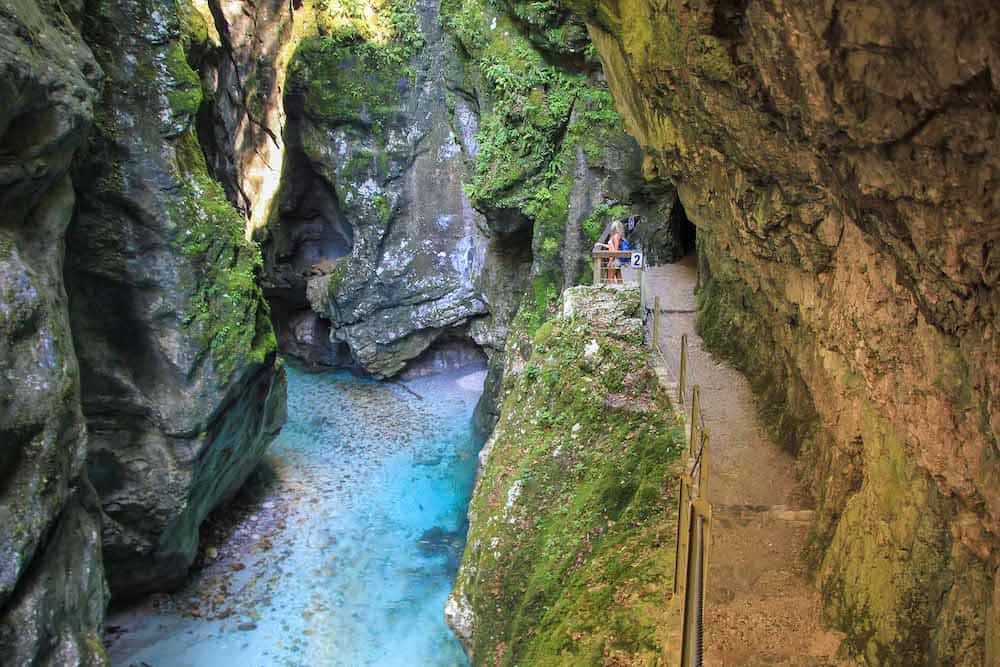
One of the best things to do here is to take the 2 km gorge-walk and enjoy stunning landscapes. Don`t worry, the Tolmin Gorges is not too long but in that short amount of time visitors get a few amazingly beautiful spots. The highlights along the trail are the Bear`s Head, The Devils Bridge, Dantes Cave and the thermal spring. All in all, this hike is going to take you around 1 ½ hour.
Getting there is easy! The gorge is only 5 minutes by car from the same named town Tolmin. In the summer month, there is a convenient shuttle service that brings guests from the town centre to the entrance.
Visiting Tolmin is a fantastic idea of any trip to Triglav National Park, and if you have time, you should definitely stay here for one or two days. The best accommodations are in Tolmin Town. Like the wonderful Hostel Hildegard, which offers lovely double rooms but also comfortable dorms beds for backpackers.
Contributed by Place of Juma
Vršič Pass
No doubt while in Slovenia, you’ll be headed to Vršič Pass, a spectacular sight not to be missed. But, what you may not already know is that on your way to Vršič pass (which by the way is the highest pass in Slovenia at 1611 meters), you will drive along and windy road – known as the Russian Road.
The road was named after the Russian Prisoners of War (POW), who had built it during World War I. The road is super bendy, and should only be driven by competent drivers. It also provides an excellent place for photos to be taken by your navigator as you slowly make your way to the top.
Keep your eyes peeled for the Russian Church; we did not notice any signs as we drove, though if you are looking out your window, it really can’t be missed, as the wooden structure stands out in a row of trees.
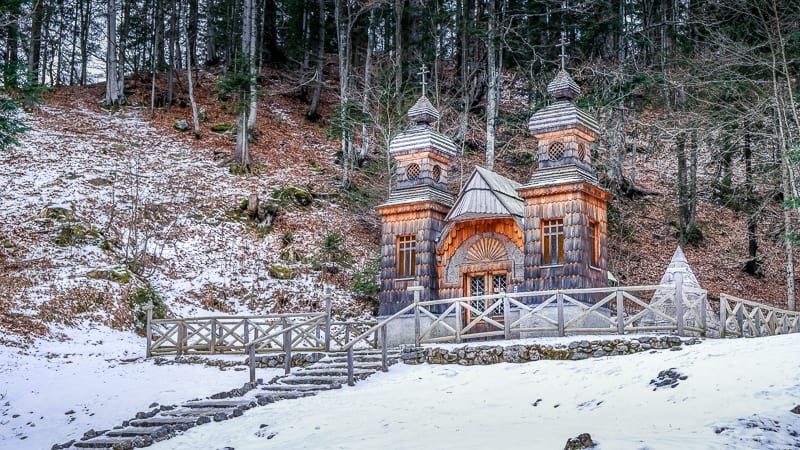
There is a small parking area for you to park safely, and make your way up the wooden stairs to reach the front of the Church. Alternatively, you can make a right and head over a little footbridge and admire the splendid structure from afar (this is the best spot for photos!).
The Church is tiny and is locked, so you are unable to enter inside. Although, I do not think that matters, the beauty can be seen from the outside.
If you go in the warmer months, it is not uncommon to find cyclists, dressed head-to-toe in cycling gear, slowly making their way up the steep road – so do watch out for them.
Contributed by Sara Jane from Chasing the Donkey
Postojna Cave
Postojna Caves is a destination not only for Slovenia’s tourism but also for Europe as a whole. Attracting more than a million visitors every year, we found ourselves blessed to simply witness the wonder of these caves. A rare and exquisite mix of natural and man-made attractions, anybody’s Slovenia’s tour will undoubtedly be incomplete without paying a visit here. Though it was quite crowded, we didn’t want to miss the party.
A park at the entrance made the entry to the caves comfortable. It was a bit cold once we were inside. So, don’t forget to dress in layers. A steep slope at the entrance forced us to speed up, so be careful while striding down the ramp at the entrance. Keep treading along the galleries to witness the fascinating natural sculptures. These look like organs when seen from afar. They are actually dripping stalactites. The inside lighting of the cave makes them look more magical and fairytale-like.
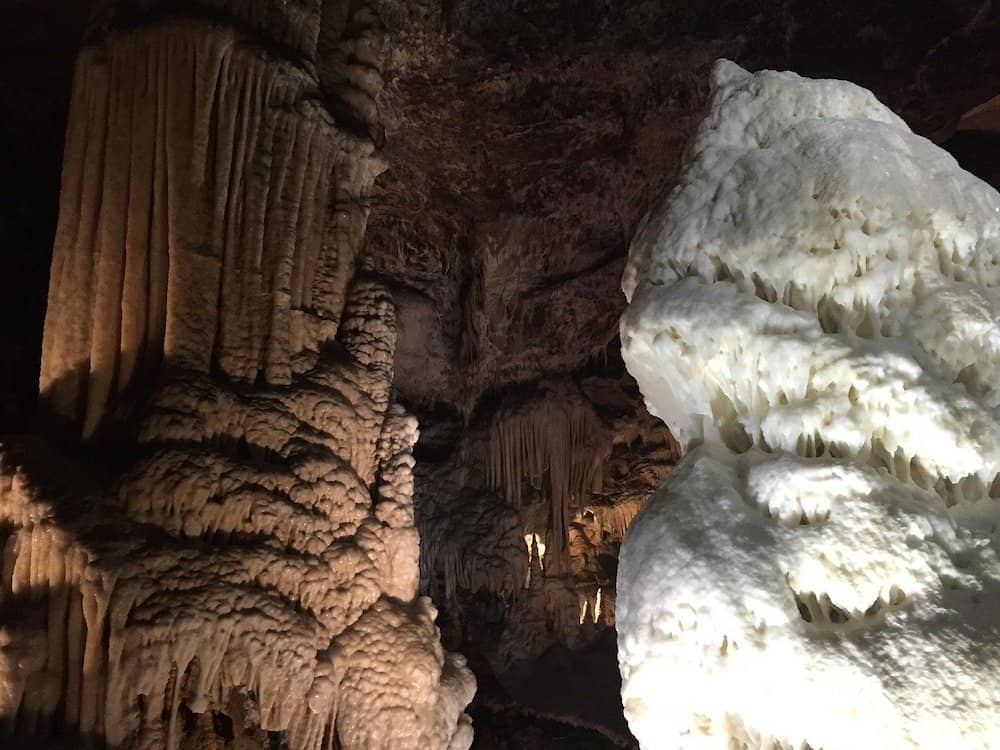
To carry the tourists inside for a more enjoyable and deeper cave tour, Slovenia’s effort to add carriage services did not go waste. A train ride was a not-to-miss opportunity as these caves boasted to be the only one in the world to get a double railway-line. The speed was a bit fast to take in the endless beautiful features of these caves but it surely was more convenient and less tiring. And we spotted a little souvenir shop at the cave’s other end from where the return train ran.
Lake Bled
We zeroed in on Bled, the majestic resort town located at foot of the Julian Alps’ and the major contributing factor was to visit the famous Lake Bled. Like every other camper, we also looked it up online before visiting and I must say that the pictures on the internet didn’t do justice. This mesmerizing lake had tourists but not jam-packed. We found our peaceful spot to soak in its beauty. The center of attraction here is Bled Island, located right in the center of the lake. Renting a rowboat and paddling to the island is an unforgettable experience. Visiting the Bled Island Church and strolling the island is just as peaceful as enjoyable.

To get a bird’s eye view of the lake’s pristine waters, we decided to tour the 11th Century, Bled Castle. I heard that it offers a spectacular view from the above. And we were not disappointed. As it offered much more. A home to a museum, a forge, a chapel, a restaurant, and a wine cellar, it seemed like a new world altogether. Wine bottling and tasting sessions are also available.
Lake Bled proved to be much more than we expected. And with family in tow, it offers fun activities like rafting, biking, paddle-boarding, and kayaking. The pristine waters of Lake Bled are also available for swimming though the season was too cold for us to do that; it’s said to be a once-in-a-lifetime experience.
Predjama Castle
If you are a Gothic fan, then Slovenia’s most famous castle, Predjama Castle, is for you. The architecture style, a huge network of secret tunnelS (not open for tourists), and a colony of bats, this castle is much more than its fairy tale exterior. Sprinkling some fun facts here: the castle holds the Guinness World Record for being the largest cave castle in the world. Since it is a well-run castle, we were prepared for a crowded spot. It had an entrance fee and we were given an informative audio guidebook that had all the interesting facts about the castle in multiple languages.
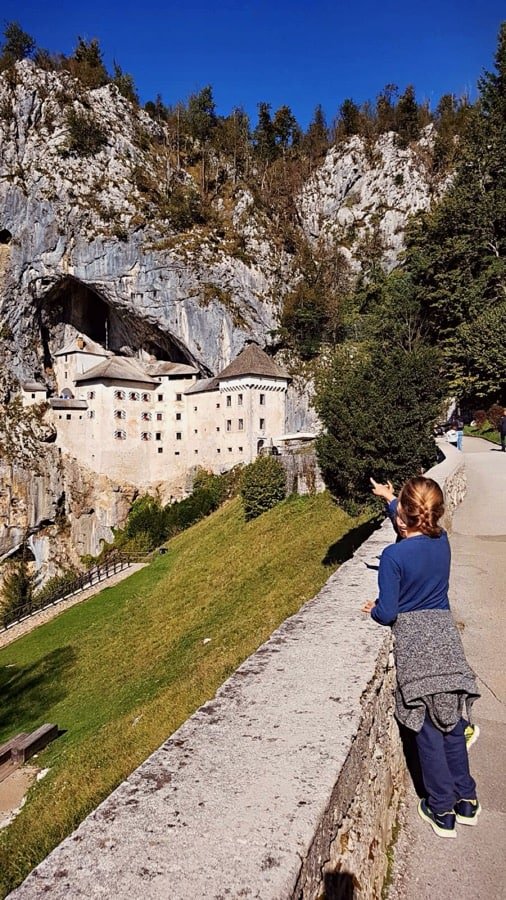
Built on the mouth of a cave, the castle survived sieges because its defenders were able to get supplies by means of secret tunnels and passageways up to the forest behind. The interior of the cave is equally a masterpiece created with a combination of natural and man-made structures. The staircase carved out of raw stone, the museum rooms housing an interesting collection of day to day objects and weapons, this castle looked like a historical movie being seen live.
With its romantic history of the famous love story of Erazem, the rebellious knight, many couples are inspired to choose Predjama castle as their wedding destination.
Explore Slovenia
Having discovered Slovenia almost by accident on our way south we promised ourselves to visit again, but almost six months later on our way home we were running from Corona Virus so we kept to main roads and only stayed in the country very briefly.
We will be going back again to spend longer there some day. That’s our promise both to ourselves and this lovely nation.
Places to visit in Slovenia

Privacy Policy Disclaimer
This website uses affiliate links for income and support.
If you like our website, please consider using these links. You will be directed to the vendor, and we will get a small commission on your purchase price at no increased cost to you.
We have researched facts stated here as far as practicable but please check anything critical before committing your time and money. We do not claim any special knowledge or expertise, and we are not consultants for our readers.